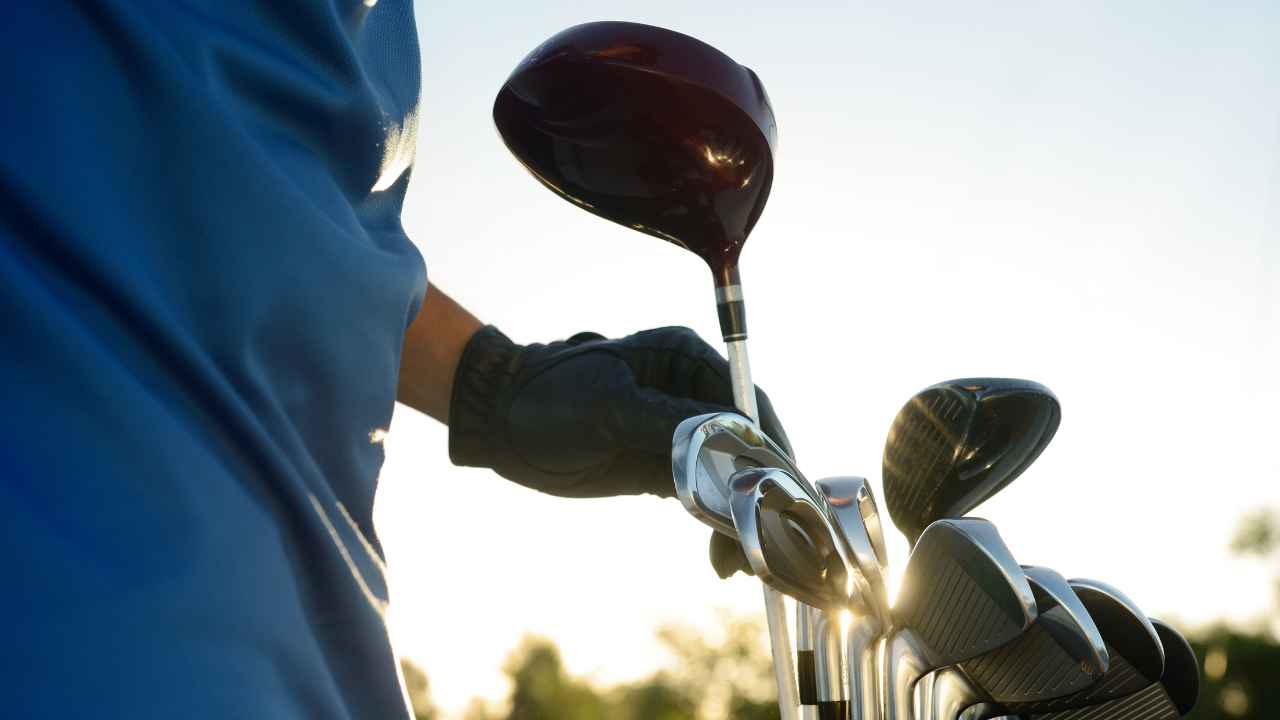The Golf shaft connects the grip to the club head and transfers power and control. Using a different shaft affects speed, accuracy, and distance. There are several types of golf club shafts, each of which affects performance.
Many professionals prefer steel shafts because they are durable and offer control. For beginners and those seeking more power, graphite shafts are ideal. Multi-material shafts combine both materials, offering strength and flexibility for versatile play.
Selecting the right shaft for your golf club can improve accuracy and distance.
Golf Club Shafts Explained
A golf club shaft is a long, tapered tube that connects the grip to the club head. It is a crucial component of a golf club and plays a significant role in its performance. Steel or graphite make up the majority of cases in most instances.
It plays an important role in the swing, as it transmits the energy of the golfer’s body to the golf ball. The length and weight of the shaft are important factors in the club’s performance.
Golf shaft design and flexibility affect how players generate and control the rotational force needed for effective ball striking.
Other characteristics also play a role. You can customize shafts to match their swing characteristics. This maximizes performance and optimizes results.
What Is Shaft’s Purpose?

The golf shaft is crucial from distance and accuracy to feel and swing dynamics. Here are its key purposes:
- Produce Rotational Force:
The shaft acts as a lever, extending your arms to increase the swing arc. This generates more centrifugal force. It translates to greater clubhead speed and, so, longer shots.
- Control Clubhead Delivery:
When the club head impacts the ground, the shaft’s stiffness and Flex are important factors. Stiff shafts promote straighter ball flight. Soft shafts promote high launch and forgiveness on off-center hits.
- Transfer Energy:
During your swing, the shaft transmits energy to the clubhead. The right shaft maximizes ball speed and power.
- Feel and Feedback:
You feel the club during the swing based on the shaft’s weight and material. A lighter shaft feels quicker but offers less feedback. A heavier shaft feels more solid but limits clubhead speed.
- Optimize Swing Timing:
The flex of the shaft affects your swing timing. Stiffer shafts need faster swings to “load”. Softer shafts are better for slower swings. When you match the flex of the shaft to your swing speed, it helps with timing and accuracy.
- Vibration Control:
Good shafts absorb unnecessary vibrations, giving golfers better feedback and smoother shots.
- Accuracy and Trajectory:
In golf, the shaft influences the trajectory of the ball. Shaft flex and design influence launch angles, accuracy, and consistency.
- Customization:
You can customize their clubs. Select shafts that suit their swing mechanics, strength, and style. This customization allows for a more tailored approach to optimizing performance.
Different Types of Golf Shafts

Advances in technology and materials have led to the development of various types of golf shafts. Below is a list of golf shafts. It includes information about their properties and their effects on golf performance.
Steel shafts
Manufacturers make steel shafts in golf clubs from durable carbon or stainless steel. The design enables them to withstand impact forces and resist corrosion. Steel shafts provide a great feel and feedback, making them a popular choice for golfers.
Also, they offer control and accuracy, which is ideal for iron shots. The shafts are also more durable than graphite shafts. They provide a longer playing lifespan.
Features:
- Known for its robustness and longevity.
- Generally cheaper than graphite shafts.
- Emphasize accuracy over distance.
- Requires a fast swing for optimal performance.
- Gradual diameter reduction for flexibility.
- Performs across all sets.
There are two types of steel shafts:
Stepped Steel Shafts:
The most common shaft type in golf clubs is the stepped steel shaft. These shafts have a distinctive step pattern visible throughout the body.
The manufacturing process involves reducing the shaft diameter. It goes from the wider butt end to the narrower tip end. It fits into the clubhead hosel.
The thinner tip and thicker top provide flexibility or kickpoints. Using this process, a shaft’s stiffness remains the same throughout a set. Several manufacturers use stepped steel shafts due to their reliability and wide use.
Rifle Steel Shafts:
Shafts made of rifle steel are unique due to their smooth, step-less design. Unlike stepped steel shafts, rifles do not have visible steps along the length. This design allows for more exact adjusting of flexes, measured using decimals (e.g., 5.0, 5.5).
Rifle shafts claim to provide greater accuracy than stepped designs. They do this by eliminating energy-robbing steps. Some rifle shafts even feature ‘flighted’ versions. It can produce different ball trajectories for clubs within a single set. It does this without steps.
Graphite Shafts
Manufacturers make graphite shafts with lightweight carbon fiber. They are a modern alternative to traditional steel shafts. Due to their ability to provide golfers with a faster swing speed, they are popular. The shafts are lighter than steel, which reduces vibrations during swings.
They are more expensive and less durable than steel. But, they offer unique flex options and vibrant colors. As a result, they are an attractive choice for golfers. This is especially true for women and seniors with slower swing speeds.
Features:
- Tends to be less durable than steel shafts.
- Weighs between 50-85 grams, lighter than steel.
- Reduce vibrations during swinging for enhanced comfort.
- found in drivers and woods, catering to golfers with slower swing speeds.
Multi-Material Shafts
Multi-material shafts represent a recent innovation in golf technology. They combine steel and graphite within a single shaft. This technology offers golfers a wide range of shaft weight, feel, and swing speed options.
It allows them to customize the shaft to their playing style and needs. Multi-material construction also reduces the shaft’s weight, making it easier to swing. The steel section enhances ball flight control. The graphite tip provides a controlled “whip” effect for increased distance in drivers.
Features:
- Suitable for use in both drivers and irons.
- Steel body for ball flight control and graphite tip for added distance.
- Graphite tip filters out unwanted vibrations at impact for an optimized shot feel.
- It offers the benefits of both steel and graphite, aiming for balanced performance.
- Manufacturers of golf equipment provide combination shafts, acknowledging their popularity.
- Golfers across a range of abilities find them in their golf bags.
Titanium Shafts
Titanium shafts offer strength and stiffness as a lightweight alternative. This is in contrast to traditional steel shafts. With this new material, golfers can increase distance while dampening vibrations.
Players seeking accuracy without sacrificing power may like titanium shafts. Especially if they reach a significant distance from the target. Manufacturers are still unclear about how to manufacture titanium shafts. But, they are a promising advancement in golf shaft technology.
Features:
- Utilizes titanium as the primary material.
- Known for its strength and stiffness characteristics.
- Offers a lighter alternative to traditional steel shafts.
- Designed to maximize shot distance for golfers.
Nanofuse Shafts
Nanofuse shafts are a breakthrough in golf shaft technology. They bridge the gap between steel and graphite. These metallic shafts are created by fusing the carbon fiber composite polymer sublayer with a nanocrystalline alloy. The nanocrystalline alloy’s tight grain structure is the secret. It enhances the alloy’s strength.
Features:
- Aims to provide traditional steel shaft consistency.
- It offers advantages in both distance and feel, akin to graphite.
- Enables a reduction in shaft weight without compromising accuracy.
- Represents an evolution in golf shaft technology.
- Combines strength, distance, and feel, overcoming traditional material limitations.
Driver Shaft
A driver shaft is crucial to producing long, accurate shots in golf. An optimal trajectory requires careful matching of these factors with the driver shaft. Individual player preferences and playing styles determine the driver shaft’s characteristics.
As the primary tool for tee shots, the driver’s shaft is crucial in determining a golfer’s success off the tee. This makes its selection a key consideration in distance and accuracy.
Features:
- Crucial for achieving the ideal ball trajectory off the tee.
- Recognized as the most significant club in the golf bag.
- Produces long shots down the fairway.
- Significant role in accuracy during tee shots.
- Adapted to match the golfer’s unique swing speed.
Different Golf Shafts Flex
You might wonder, Is shaft flex important? Well, If you want to select the right club for your game, you need to consider the flex of the shaft.
Different shafts have different flexes. Flexes affect the club’s performance and feel. A shaft with a higher flex will be easier to hit, while a shaft with a lower flex will be more accurate.
Let’s have a look at different shaft flex options:
Extra Stiff (XX)
Elite golfers are designed for a shaft flex with Extra Stiff (XX). They have fast swing speeds. For those achieving 95-110 mph clubhead speeds and beyond, this category provides the most control and precision.
Seasoned players often carry it. Harnessing its benefits demands high skill. These clubs are for professional golfers who average 110 miles per hour or more. They hit the ball around 270 yards.
Stiff (X)
It is a step down in rigidity from Extra Stiff, but it is still intended for golfers with fast swing speeds. It is recommended for taller golfers or those with swings surpassing 95 miles per hour.
This category suits individuals carrying drives over 230 yards. For golfers who hit 240-270 yards but desire enhanced accuracy, Stiff Flex is the perfect fit. Stix recommends this category for golfers of average to advanced skill levels. Players of all skill levels will find this category a versatile choice.
Regular (R)
Among recreational golfers, the regular shaft (R) flex is the most popular. Due to its well-rounded features, the Regular Flex is a popular choice for all swing speeds.
Over 80% of golfers prefer Regular Flex. It’s designed for those with swings ranging between 80 and 95 miles per hour. As a result, you can carry the ball 200-230 yards. It offers a balanced option for players of all levels. It’s for semi-regular to intermediate players.
Senior (A)
Designed for golfers over 60, the Senior (A) shaft flex recognizes a slowing swing speed with age. Senior Flex allows older golfers to maintain an enjoyable and effective golfing experience.
Amateur or medium Flex calls it, but it caters to swing speeds of 75-85 mph with carry distances of 180-200 yards. Active Flex encompasses the capabilities of a Senior Flex club. But, Stix recognizes the specific needs of this group.
Ladies (L)
The Ladies’ (L) shaft flex is designed for female golfers. It accommodates swing speeds within or below 75 mph. Having a carry distance of 180 yards or less.
Like the Senior Flex, Ladies’ flex shafts may differ in length. Female golfers need flexibility and forgiveness for the best performance. This category addresses those needs.
Active Flex
Golfers with slow swings would enjoy Active Flex because it propels the club head faster. This Flex suits most juniors, women, and seniors who drive the ball under 200 yards. Stix offered Active Flex, simplifying the options without compromising performance.
Junior Flex
Junior Flex clubs are lightweight and designed for swing speeds below 75 miles per hour. They are like Stix’s Active Flex clubs. They are important for junior players’ success and enjoyment.
How To Choose the Right Shaft For Your Clubs
You must consider both fair measurements and subjective feel when choosing shaft flex. Here are seven steps to help you make a smart choice:
- Speed and distance
Take note of each ball’s distance before hitting the ground on the driving range. Exclude the longest and shortest distances to cut outliers. Calculate the average of the remaining distances.
- Swing speed calculation:
Divide your average drive distance by 2.3 to determine your average swing speed in miles per hour. For example, if your average drive is 220 yards, your average swing speed is approximately 95 mph.
- Check Flex Charts:
Make sure your swing speed matches the recommended shaft flex provided by manufacturers. These charts categorize flex options based on swing speed ranges.
- Other factors:
While numbers provide a starting point, don’t rely on them. Consider your feelings and preferences. If a golfer’s comfort and style don’t match the recommended Flex, they may deviate.
- Flex Test:
Experiment with clubs featuring different flexes on the driving range. You can also try them during a practice round. With this hands-on approach, you can assess how each Flex feels.
- Trust Your Feel:
You can’t play golf by looking at the numbers; you must feel it. You should always trust your instincts if a flex doesn’t feel right.
- Flex and Shaft Length Charts:
Leverage shaft length and flex charts provided by manufacturers. You can use these charts to choose the right length and Flex for your clubs.
Keep in mind that there is no “right” flex for everyone. It’s about finding the sweet spot that gives you control, feel, and the desired ball flight. So, experiment, listen to your body, and most of all, have fun on the course!
FAQs
What golf club shaft should I use?
It depends on your swing speed and the type of club. A heavier shaft can increase swing speed. A lighter shaft can provide more control.
What golf shaft is best for beginners?
For beginners, the best golf shafts are graphite rather than steel. Beginners can generate more clubhead speed and distance with a lighter weight.
What’s better graphite or steel shafts?
Graphite shafts are more expensive but offer greater forgiveness and a better feel. Steel shafts are cheaper but have a more traditional feel. In the end, the best golf shaft depends on playing style and budget.
How do I know if I need a stiff or regular shaft?
It depends on your swing speed, tempo, and skill level. A fast swing often benefits from a stiff flex, providing control. If you seek added distance, consider a regular flex shaft.
How do I choose an iron shaft?
Consider factors like torque, which indicates how resistant a shaft is to twist. High swing speeds must have low torque (around 2-3 degrees). When swing speeds are slower, high torque (around 5+ degrees) allows for more flexibility.
Final Note
Usually, the types of golf club shaft you choose can impact your game. Consider your swing and playing style when selecting a shaft. Decide whether you prefer graphite or steel. Graphite shafts are lighter and more forgiving. Steel shafts are heavier and more stable.

